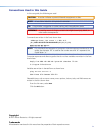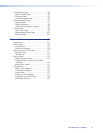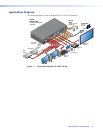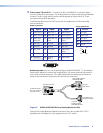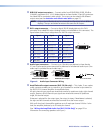
DVS 510 Series • Introduction 3
• PIP (picture-in-picture) — Allows a video source to be displayed within a high
resolution image, or vice versa. Audio switching can be set to follow either the main
or PIP window.
• Glitch-free switching — Switching between sources occurs without distortions or
glitches with selectable cut or fade-to-black transitions.
• Customizable front panel control buttons — The tri-colored, backlit pushbuttons
on the front panel can be custom-labeled.
• Power Save Mode — The DVS 510 can be set to mute video and sync output to
the display device when no active input signal is detected. This allows the projector
or flat-panel display to automatically enter into standby mode to save energy and
enhance lamp or panel life.
• HDMI signals support — When used with optional Extron HDMI-DVI adapters, the
DVI inputs and output on the DVS 510 are compatible with HDMI. The DVS 510 fully
passes audio and auxiliary data as part of the HDMI signal, ensuring audio and video
compatibility with downstream HDMI-equipped devices.
• Audio switching and output volume control — The DVS 510 features audio
switching for 10 stereo balanced or unbalanced input sources, and provides master
volume control and muting as well as bass and treble controls. Fixed and variable line
level outputs are available, and each output can be balanced or unbalanced. Stereo
input signals can be output as dual mono.
• Audio or video breakaway — Lets you break an audio signal away from its
corresponding video signal and route it to the audio outputs, allowing the audio
channels to be operated as a separate scaler.
• Integrated audio delay — Delays the audio output automatically to compensate for
latency introduced by the video processing.
• Amplifier (DVS 510 SA only) — The DVS 510 SA has a stereo power amplifier
with 25 watts rms per channel into 4 or 8 ohms. The Class D amplifier design
includes CDRS™ – Class D Ripple Suppression, an Extron patented technology that
provides a smooth, clean audio waveform and an improvement in signal fidelity over
conventional Class D amplifier designs. CDRS eliminates the high frequency switching
ripple characteristic of Class D amplifiers, a source of RF emissions that can interfere
with sensitive AV equipment such as wireless microphones.
The DVS 510 SA includes technology for the integrated amplifier that detects the
onset of clipping by comparing input and output signals. Gain is reduced with a slow
attack and fast release to eliminate clipping and protects the speakers from clipping
distortion.
• Picture controls — Brightness, contrast, color, tint, detail, horizontal and vertical
positioning, sizing, and zoom can be set. 16 user memory presets are available for
each input to store all image settings.
• Automatic 3:2 and 2:2 pulldown detection — Advanced film mode processing
techniques help maximize image detail and sharpness for NTSC, PAL, and HDTV 1080i
sources that originated from film.
• Motion adaptive 1080i deinterlacing — High performance deinterlacing is
provided for 1080i signals from HD sources, including cable or satellite set-top devices,
delivering optimized image quality through advanced motion compensation.
• Aspect ratio control — The output can be designated to meet a specific aspect ratio
requirement so that the image fills the screen, or is displayed with compensation for
the native aspect ratio of the source.
• Quad standard video decoding — A digital, four-line adaptive comb filter decodes
NTSC 3.58, NTSC 4.43, PAL, and SECAM for integration into systems worldwide.






